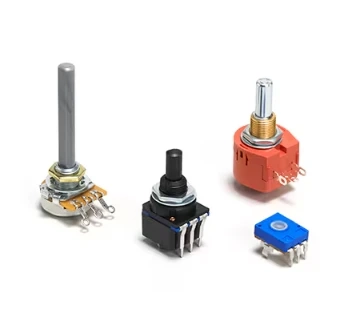What is Potentiometer
A potentiometer, often called a pot, is a variable resistor used to control electrical resistance in a circuit. It consists of a resistive element and a movable wiper that adjusts the resistance by changing its position along the element. This mechanism makes potentiometers useful for applications such as volume control in audio devices.
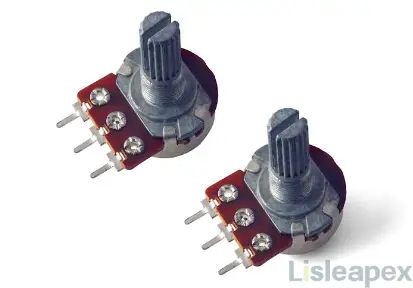
Potentiometers operate on the principle of varying resistance. As the wiper moves along the resistive element, the contact point changes, altering the resistance proportionally to the wiper\'s position. They can be constructed with either wirewound or composition resistance elements, with the general design including a base, resistance element, terminals, sliding contact arm, rotatable shaft, threaded bushing, and cover.
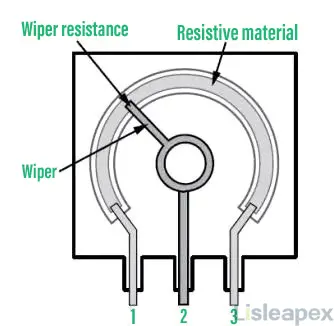
Construction of Potentiometers
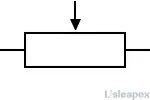
symbol of Potentiometers
#1 Types
Potentiometers, commonly referred to as pots, come in various types and configurations to suit different applications. They can be broadly classified into rotary, linear, digital, and trimmer potentiometers. Each type has unique characteristics and is suited for specific uses.

Rotary Potentiometers: Rotary potentiometers are the most common type, featuring a wiper that moves along a circular path. They include single-turn pots for simple applications, multi-turn pots for high precision, dual-gang pots for parallel adjustments, concentric pots for combined controls, and servo pots for both manual and automatic adjustments.
Linear Potentiometers: Also known as slide pots or faders, linear potentiometers have a wiper that moves along a straight path. They are used for single-channel control or precise measurements and come in single-slide, dual-slide for parallel control, multi-turn for high precision, and motorized versions for automated adjustments.
Digital Potentiometers: Digital potentiometers are electronically controlled and consist of an array of small resistive components in series with switches that act as virtual wiper positions. They are controlled by digital signals or protocols like I²C and SPI, making them suitable for precise and programmable resistance adjustments.
Trimmer Potentiometers: Trimmer potentiometers, or trimmers, are small adjustable resistors used for fine-tuning circuits. They are typically adjusted during assembly or servicing and do not require frequent changes, making them ideal for setting precise resistance values in stable applications.
#2 Features
- Adjustable Voltage Control: Potentiometers are primarily used for adjusting voltage levels in circuits.
- Three-Terminal Design: They have three terminals—input, output, and wiper—for precise resistance adjustment.
- Ease of Use: They are simple to install and use, often with a knob for manual adjustment.
- Common in Audio Devices: Widely used in applications like volume controls, tuning circuits, and measurement of positions.
- Variety of Types: Available in rotary and slider forms, and in various resistance values.
- Durability: Generally reliable but may wear out with extensive use.
- Low Current Applications: Less suitable for high-current applications due to limited current-handling capability.
#3 Application
Volume Control: Potentiometers are widely used in audio equipment such as radios and amplifiers to adjust the sound level by varying the resistance in the audio signal path, allowing users to increase or decrease volume.
Tone Control: In audio systems, potentiometers adjust audio frequencies to modify the sound quality. They help in shaping the tone by changing the resistance in the signal path, allowing users to enhance or reduce bass and treble.
Brightness Control: Potentiometers are employed in display screens and lighting systems to regulate brightness levels. By adjusting the resistance, they control the amount of current flowing through the light source, thus altering its brightness.
Calibration: In various electronic instruments, potentiometers are used for precise calibration. They adjust circuit parameters to ensure accurate measurements and performance, making them essential for tuning and fine-tuning electronic devices.
Position Sensing: Potentiometers are used in sensors to measure and adjust mechanical positions. They provide feedback on the position of moving parts in robotics and mechanical systems by varying resistance as the wiper moves along the resistive element.
#4 Advantages and Disadvantages
Advantages:
- Ease of Use and Installation: Potentiometers are user-friendly and straightforward to install, making them ideal for a variety of applications.
- Versatility in Audio and Voltage Control: They are highly suitable for applications requiring precise control of audio levels and voltage, such as volume knobs and tone controls.
- Wide Range of Resistance Values: Available in numerous resistance values, potentiometers can meet diverse application needs.
Disadvantages:
- Limited High-Current Application: Potentiometers are generally not designed to handle high current, making them less suitable for such applications.
- Wear and Tear: With extensive use, the mechanical parts of potentiometers can wear out, potentially affecting their performance and longevity.
What is Variable Resistor
A variable resistor is an electro-mechanical component that allows for the adjustment of its electrical resistance value. This adjustment is typically achieved by sliding a contact (wiper) over a resistive element. When a variable resistor is utilized with all three terminals, it functions as a potentiometer, serving as a potential divider. If only two terminals are used, it acts as a rheostat, providing variable resistance.
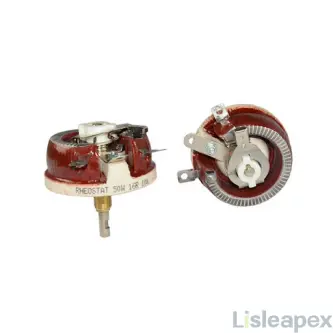
Variable resistors, including both potentiometers and rheostats, are essential in applications where frequent manual adjustment of resistance is required, such as in volume, tone, focus, and brightness controls. Potentiometers, which have three terminals, are commonly used as voltage dividers and offer a wide range of resistance values but usually handle lower currents. Rheostats, on the other hand, typically have two terminals, handle higher currents, and have a more limited range of resistance values. Digital potentiometers are electronically controlled versions, allowing resistance adjustment without mechanical movement.
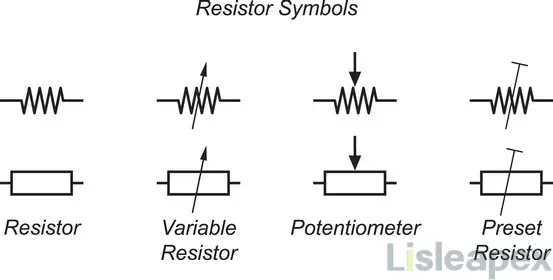
Symbol
#1 Types
Variable resistors, which allow for adjustable resistance in electrical circuits, come in several forms to suit different applications. They are essential for tasks like tuning circuits, controlling audio volume, and adjusting lighting levels. The three primary types are potentiometers, rheostats, and digital resistors, each with unique characteristics and uses.
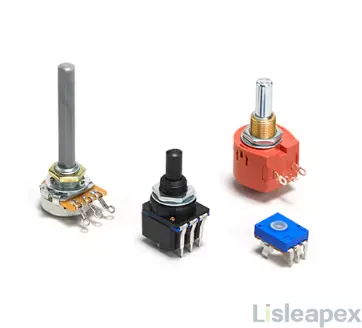
Potentiometer: Potentiometers function as resistive dividers and are widely used to generate voltage signals based on the wiper\'s position. They are commonly found in applications like amplifier gain control, distance measurement, and circuit tuning. Trimmer potentiometers, or trimpots, are small adjustable versions used for fine-tuning on circuit boards.
Rheostat: Rheostats are used as variable resistances and have two terminals instead of three. One terminal is at the end of the resistive element, and the other is at the wiper. Historically used for power control, they are now mainly used for circuit tuning and calibration, with modern power control achieved through more efficient electronics.
Digital Resistor: Digital resistors adjust resistance electronically via digital signals rather than mechanical movement. They change resistance in discrete steps and are often controlled by digital protocols like I2C or simple up/down signals, making them ideal for applications requiring precise and programmable resistance adjustments.
Rotary Variable Resistors: These resistors feature a knob that can be turned to change the resistance. They are commonly used for manual adjustments in settings such as audio volume and lighting brightness.
Slide Variable Resistors: Slide variable resistors have a slider that moves along a resistive track to alter the resistance. They are often used in applications where linear adjustment is preferred, such as in audio mixing boards.
#2 Features
- Precise Current Control: Ideal for applications that require fine-tuning of current flow.
- Two or Three Terminals: Can have two terminals (rheostat) or three terminals (variable resistor).
- High-Current Handling: Suitable for high-current applications, providing robust current control.
- Durability: Built to last and withstand extensive use.
- Various Types: Includes rotary and slide types, each suitable for different applications.
- Limited Resistance Options: Generally offers fewer resistance values compared to potentiometers.
- Calibration and Tuning: Often used for circuit calibration and tuning, ensuring optimal performance.
Read more:Potentiometer vs Variable Resistor: What are Differences and How to Choose


